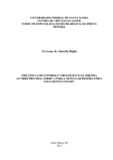| dc.contributor.advisor | Silva, Antônio Marcos Vargas da | |
| dc.creator | Righi, Geovana de Almeida | |
| dc.date.accessioned | 2018-03-16T13:48:41Z | |
| dc.date.available | 2018-03-16T13:48:41Z | |
| dc.date.issued | 2017-08-09 | |
| dc.date.submitted | 2017 | |
| dc.identifier.uri | http://repositorio.ufsm.br/handle/1/12733 | |
| dc.description | Monografia (especialização) - Universidade Federal de Santa Maria, Centro de Ciências da Saúde, Curso de Especialização em Reabilitação Físico-Motora, RS, 2017. | por |
| dc.description.abstract | Since the introduction of the antiretroviral therapy (ART), the life expectancy of Human Immunodeficiency Virus (HIV) carriers has increased, thus, being the viral load monitoring a tool for the progression evaluation of the HIV. The respiratory muscle weakness already has been cited in previous studies and it is present in this population, although there are no reports comparing different levels of viral load. The objective of this study was to evaluate the influence of the viral control and the use of the antiretroviral therapy on respiratory muscle strength in HIV patients. Cross-sectional study, 60 patients with HIV, both sexes, subdivided in three groups: with ART and load viral not detectable (AGVL-; n=20); with ART and load viral detectable (AGVL+; n=20); without ART and load viral detectable (nAGVL+; n=20). The respiratory muscle strength was measured through digital manovacuometer. The load viral was lower in the AGVL+ than in nAGVL+, since the AGVL- has showed load viral not detectable. The counting of T-CD4 cells was bigger in AGVL- than the others. The groups AGVL+ and nAGVL+ demonstrated inspiratory muscle weakness (MIP<70% of the predicted). The patients group using ART with load viral not detectable showed bigger expiratory muscle strength and were not classified with inspiratory muscle weakness. These favorable effects of the ART and of lower load viral may result in better functional outcomes. | eng |
| dc.language | por | por |
| dc.publisher | Universidade Federal de Santa Maria | por |
| dc.rights | Acesso Aberto | por |
| dc.rights | Attribution-NonCommercial-NoDerivatives 4.0 International | * |
| dc.rights.uri | http://creativecommons.org/licenses/by-nc-nd/4.0/ | * |
| dc.subject | HIV (Vírus da Imunodeficiência Humana) | por |
| dc.subject | Testes de função respiratória | por |
| dc.subject | Terapia antirretroviral | por |
| dc.subject | Pulmonary function tests | eng |
| dc.subject | Antiretroviral therapy | eng |
| dc.title | Influência do controle virológico e da terapia antirretroviral sobre a força muscular respiratória em sujeitos com HIV | por |
| dc.title.alternative | Influence of virological control and antiretroviral therapy on respiratory muscle force in HIV-subjects | eng |
| dc.type | Trabalho de Conclusão de Curso de Especialização | por |
| dc.degree.local | Santa Maria, RS, Brasil | por |
| dc.degree.specialization | Reabilitação Físico-Motora | por |
| dc.description.resumo | Desde a introdução da terapia antirretroviral (TARV), a expectativa de vida de portadores do vírus Human Immunodeficiency Virus (HIV) tem aumentado, sendo o acompanhamento da carga viral uma ferramenta para monitoração da progressão do HIV. A fraqueza muscular respiratória já foi apontada em estudos anteriores e está presente nesta população, porém não há relatos comparando diferentes níveis de carga viral. O objetivo deste estudo foi avaliar a influência do controle virológico e do uso de terapia antirretroviral sobre a força muscular respiratória em pacientes com HIV. Estudo transversal com 60 pacientes com HIV, subdivididos em três grupos: com TARV e carga viral não detectável (GTCV-; n=20), com TARV e carga viral detectável (GTCV+; n=20) e sem TARV e carga viral detectável (GsTCV+; n=20). A força muscular respiratória foi mensurada com manovacuômetro digital. A carga viral foi menor no GTCV+ do que no GsTCV+. A contagem de células T-CD4 foi maior no GTCV- do que nos demais. Os grupos GTCV+ e GsTCV+ apresentaram redução da PEmáx na comparação com o GTCV-, baseado no % do predito. Tanto o GTCV+ quanto o GsTCV+ apresentaram valores de mediana que demonstram fraqueza muscular inspiratória (PImáx<70% do predito). O grupo de pacientes em uso de TARV e com carga viral não detectável apresentou maior força muscular expiratória e não foi classificado com fraqueza muscular inspiratória. Estes efeitos favoráveis da TARV e da baixa carga viral podem implicar em melhores desfechos funcionais. | por |
| dc.publisher.country | Brasil | por |
| dc.publisher.initials | UFSM | por |
| dc.subject.cnpq | CNPQ::CIENCIAS DA SAUDE | por |
| dc.publisher.unidade | Centro de Ciências da Saúde | por |



